
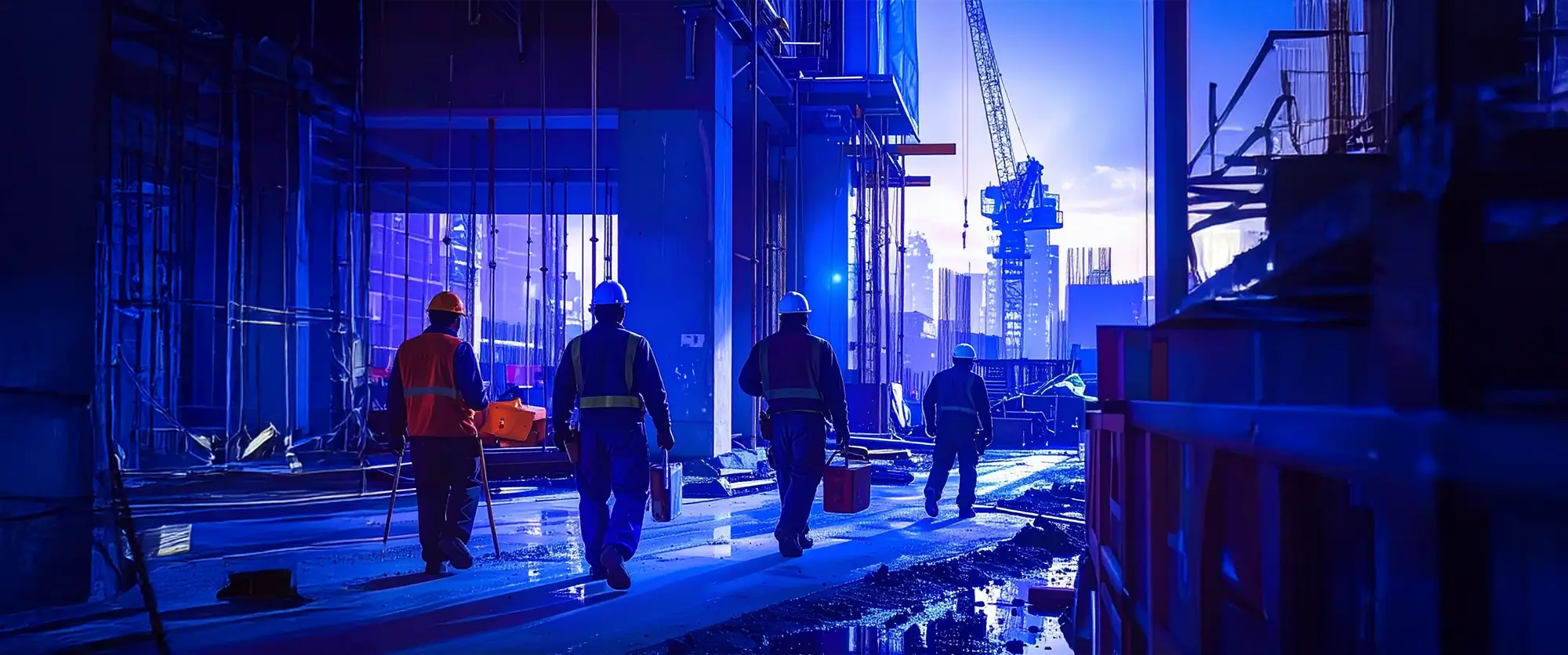
Construction Equipment Cost Estimating: Your Complete Guide
TL;DR: Unpredictable construction equipment costs and missed budgeting steps are major causes of blown project budgets. This guide details how to estimate equipment costs accurately, covering all relevant cost factors, key benchmarks, and proven workflows. You’ll leave with practical cost data tools, field-tested strategies, and insights for smarter construction equipment costing and more cost-effective bids.
Why Construction Equipment Costing Is Essential for Project Success
Building accurate budgets is challenging, but unclear equipment expenses can disrupt project financial planning and the company's success. If your construction equipment costs are underestimated, profits shrink, or projects run off track with little warning.
In the construction industry, numerous contractors struggle with shifting purchase prices, variable costs tied to project requirements, and changes in market supply and demand. Outdated spreadsheets or missing cost data leave you open to costly mistakes. It’s all too common to overlook hidden costs, including maintenance, repairs, insurance, and resale value, or fail to allocate expenses fairly across jobs.
The good news? Construction businesses using modern cost estimation tools, and understanding all key factors affecting equipment costs, deliver more accurate estimates and put bid overruns behind them. With effective equipment management, construction teams leverage cost-effective solutions and up-to-date cost data to inform every financial decision.
Ready to estimate equipment cost with confidence? This guide walks you through construction equipment costing fundamentals, best practices, current trends, and advanced methods for reliable equipment ownership modeling and cost control.
Key Factors That Impact Construction Equipment Costs
Construction equipment costs vary depending on several factors, from purchase price to the costs of ongoing maintenance and repair. Identifying and understanding these elements is essential for accurate estimating and cost-effective project execution.
Main Components of Equipment Costs
Estimating construction equipment costs goes beyond just the initial purchase price. The total cost includes:
- Initial purchase price (or lease payment)
- Transportation, delivery, and assembly
- Sales tax and installation fees
- Recurring maintenance and annual repair costs
- Fuel usage and fuel efficiency
- Insurance costs and property taxes
- Operator wages and training
- Depreciation and decreasing resale value
- Storage and equipment management
- Repair costs and unexpected emergency repairs
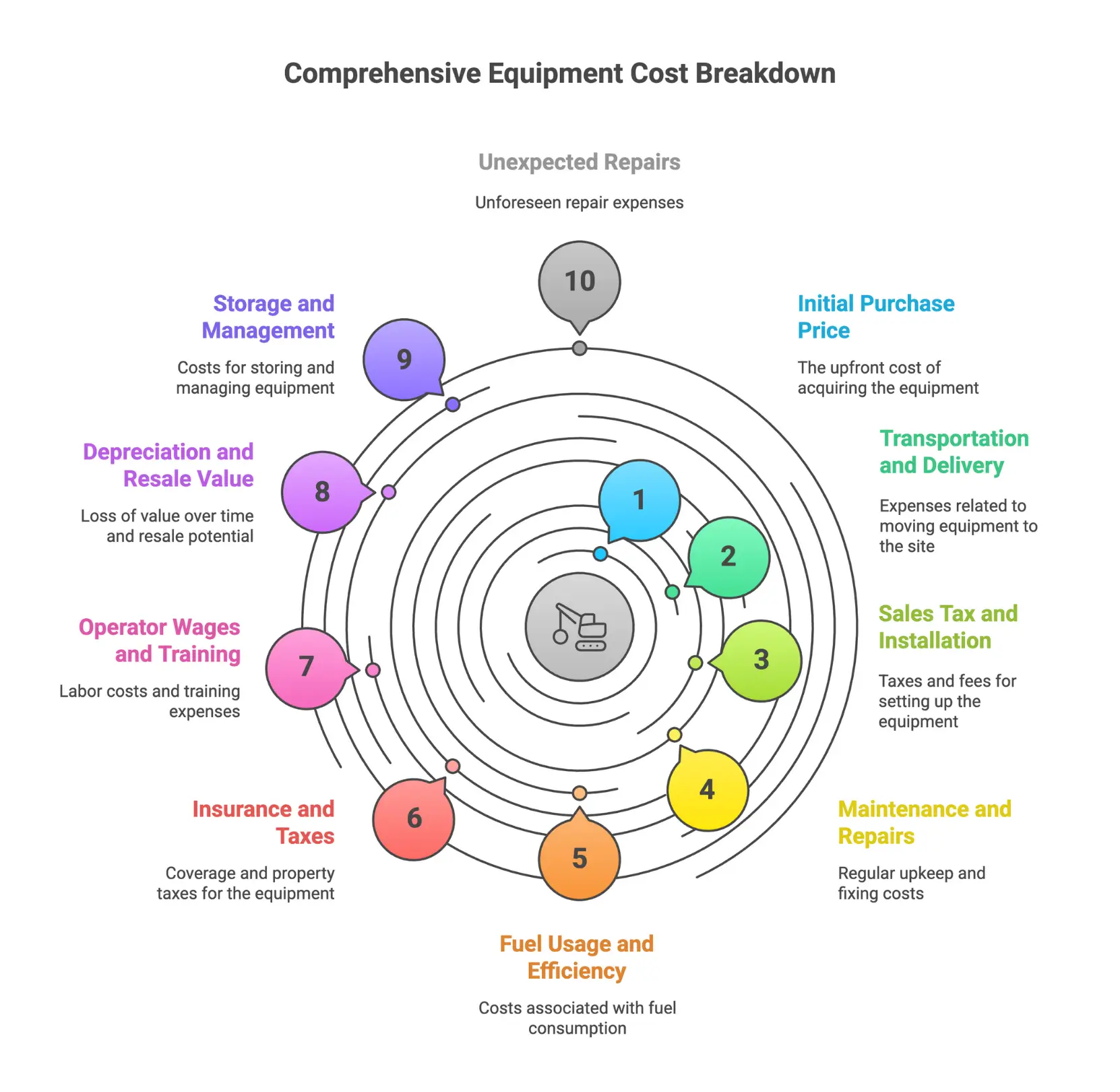
Every equipment expense should be accounted for, including hidden costs that might surface unexpectedly during a project’s life cycle.
Construction Equipment Ownership vs. Renting
A crucial decision for many contractors is whether to purchase or lease new or used equipment. Purchasing or leasing equipment comes with financial planning implications. Ownership costs include the upfront cost, ongoing operating costs, and eventual resale value. For long-term, high-utilization jobs (900+ hours per year), purchasing new equipment or reliable used models may be more cost-effective. Renting equipment is often better for short-term requirements, minimizing upfront cost and avoiding depreciation.
Role of Market Conditions and Equipment Type
Market forces, such as high demand or disrupted supply chains, impact equipment costs. New machines equipped with advanced technology or superior safety features have higher purchase prices. Used construction equipment can be 25% to 50% less expensive, though costs vary depending on the unit’s age and condition. Geographic location, project requirements such as job site terrain or climate, and brand reputation also affect overall cost.
Cost Data and Historical Benchmarks
Learning from historical data, including past project records, equipment expenses, and fleet management logs, provides benchmarks that strengthen new estimates. Tracking these figures over time helps you anticipate variability in operating costs and maintenance, making your future estimates more accurate.
Types of Construction Equipment and Their Cost Characteristics
Construction businesses rely on a range of heavy equipment types, from compact equipment like skid steers and compact track loaders to heavy machinery such as excavators, bulldozers, and cranes. Each category features different cost drivers and ownership considerations.
Heavy Equipment vs. Compact Equipment
- Heavy equipment (excavators, wheel loaders, cranes): Typically has higher purchase price, greater operating expenses, and longer useful life.
- Compact equipment (skid steers, compact track loaders): Lower upfront cost and maintenance, easier to transport, best-fit for space-limited projects.
Example: Compact Track Loaders
Compact track loaders are valued for their versatility and lower ground impact. They are a cost-effective essential tool for small to medium project requirements, often commanding a higher resale value compared to older models of similar size. Construction businesses should evaluate new vs. used equipment options, considering fuel efficiency and projected repair costs.
How to Estimate Equipment Cost for Construction Projects
A cost effective equipment cost estimate delivers more reliable budgets and better project outcomes. Here’s a structured approach to estimate equipment cost with confidence:
1. Define Equipment Needs Based on Project Requirements
List all necessary construction equipment, factoring in project size, job site conditions, terrain, and access constraints. Understanding equipment types up front helps you make informed decisions that match actual needs.
2. Gather Accurate Cost Data
Research the current market for purchase price, lease rates, and rental options. Consider:
- Upfront purchase price or leasing equipment rates
- Operating costs: maintenance, repairs, fuel, insurance
- Resale value and projected useful life
3. Calculate Equipment Costs: Ownership and Operation
Break down expenses for ownership versus usage:
- Ownership costs: depreciation, financing options and interest rates, insurance, taxes, and storage. Use historical data from previous equipment purchases to improve accuracy.
- Operating costs: variable costs due to fuel usage, operator wages, maintenance, and repairs.
Total cost equals initial cost plus ongoing expenses (maintenance, repairs, insurance, operating expenses) minus estimated resale value.
4. Use Standardized Templates and Cost Management Software
Adopt templates for listing and tracking all cost categories, ensuring nothing is missed and all estimates are consistent. Advanced cost management and fleet management platforms help automate data capture, track actual monthly costs, and integrate with business intelligence tools.
5. Add a Contingency Buffer
Cost overruns are frequent in the construction industry. Building a reasonable buffer into your budget helps prevent costly breakdowns or surprises from derailing the project.
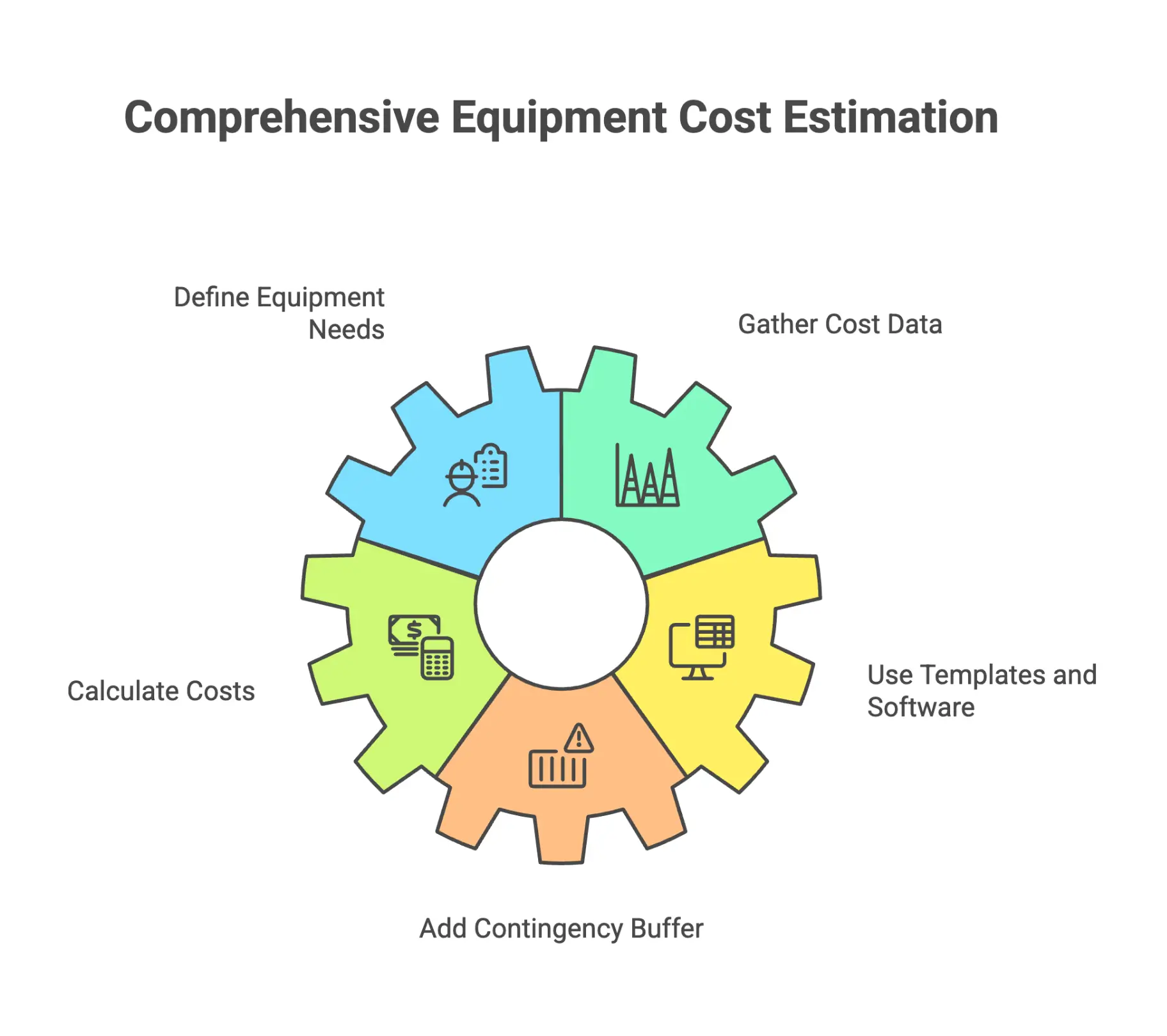
Methods and Best Practices for Accurate Construction Equipment Cost Estimating
Construction Equipment Costing Methods
There are multiple ways to estimate equipment cost, varying depending on job complexity:
- Unit-rate estimating: Calculate costs using cost data for estimated hours or quantities.
- Detailed estimating: Itemize every direct and indirect expense.
- Parametric modeling: Reference cost libraries for fast, project-specific estimates.
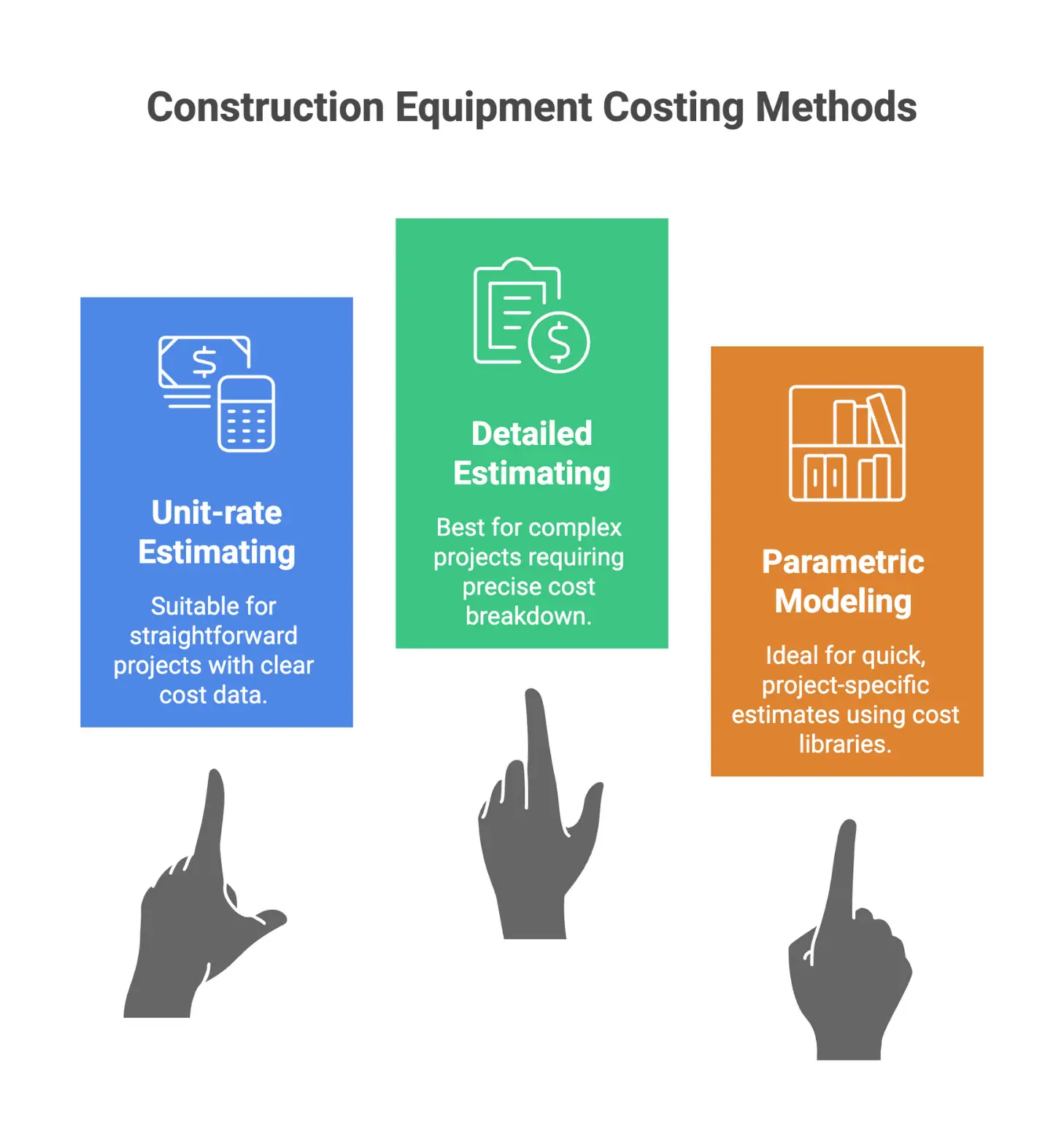
Flexibility is critical. Utilize the approach matching your equipment management and job requirements.
Pooling and Allocating Equipment Costs
Allocating equipment costs fairly across multiple projects improves financial transparency. Pool all related expenses, including operating, maintenance, and insurance costs, and assign them to each project based on proportional usage by hours operated, mileage, or project milestones.
Example: If heavy equipment is used for 200 out of 2,000 hours in a year, only 10% of the annual costs should be allocated to that project.
Hidden and Variable Costs of Construction Equipment Ownership
Many contractors underestimate hidden costs and variable costs related to equipment ownership:
- Maintenance: Routine maintenance and unexpected repairs are critical components. Skimping here can lead to higher long-term costs and costly breakdowns.
- Insurance: Annual insurance costs vary from 1% to 5% of a machine’s total cost. Factors include the type of work, project location, and provider.
- Fuel efficiency: More efficient models cost more upfront but may save money through lower operating expenses.
- Repair costs and part replacements: Older used equipment may require more frequent repairs. Emergency repairs can disrupt schedules and increase overall expenses.
- Storage: Costs range from $500 to $1,000 per month, depending on region and equipment size.
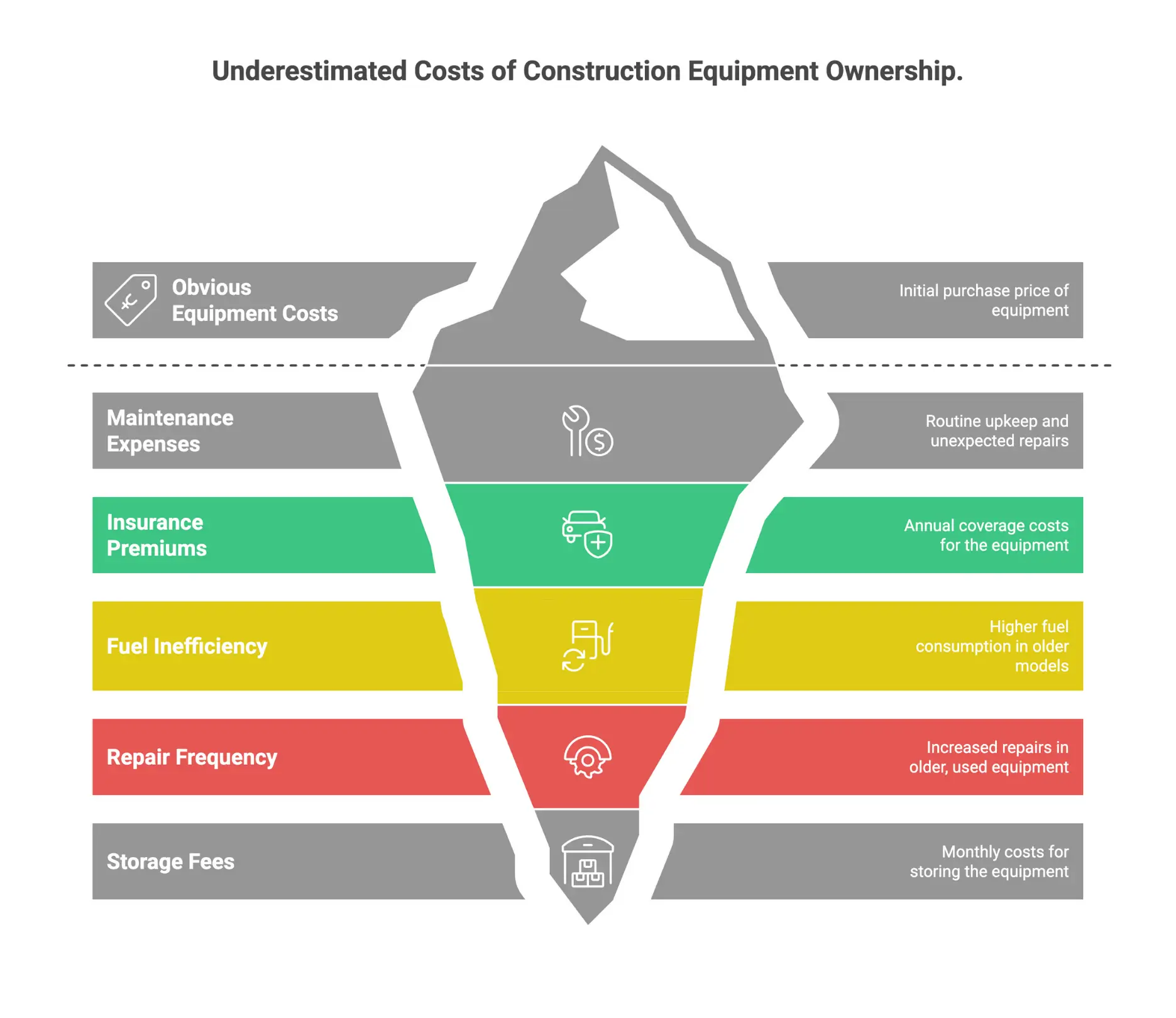
Utilizing equipment management software is an essential tool for streamlining operations, maximizing asset life, and preventing losses.
Buying New vs. Used Construction Equipment
New Equipment
- Higher initial cost and upfront cost
- Comes with manufacturer warranties and the latest technology
- Subject to the steepest depreciation
- Stronger resale value, though market conditions and inflation can fluctuate
Used Equipment
- 25% to 50% lower purchase price
- Upfront savings, but may incur higher annual repair costs and repairs
- Shorter useful life and less predictable downtime
- Watch for older models, which may have higher insurance costs and repair frequency
When choosing between new or used equipment, consider the total cost, upcoming project requirements, and the equipment’s projected usage over its useful life.
Trends Affecting Construction Equipment Pricing
Construction equipment pricing is shaped by current trends and market factors:
- Inflation: Some categories have seen price increases over 25% in recent years.
- Supply chain issues: Extended wait times for new machines and higher demand for used equipment.
- Technology integration: Adds up-front expense but can extend the useful life and decrease breakdowns.
- Global demand: Infrastructure spending, tariffs, and local regulations affect pricing for both new and used construction equipment.
- Peak seasonality: Rental rates rise during busy spring and summer months.
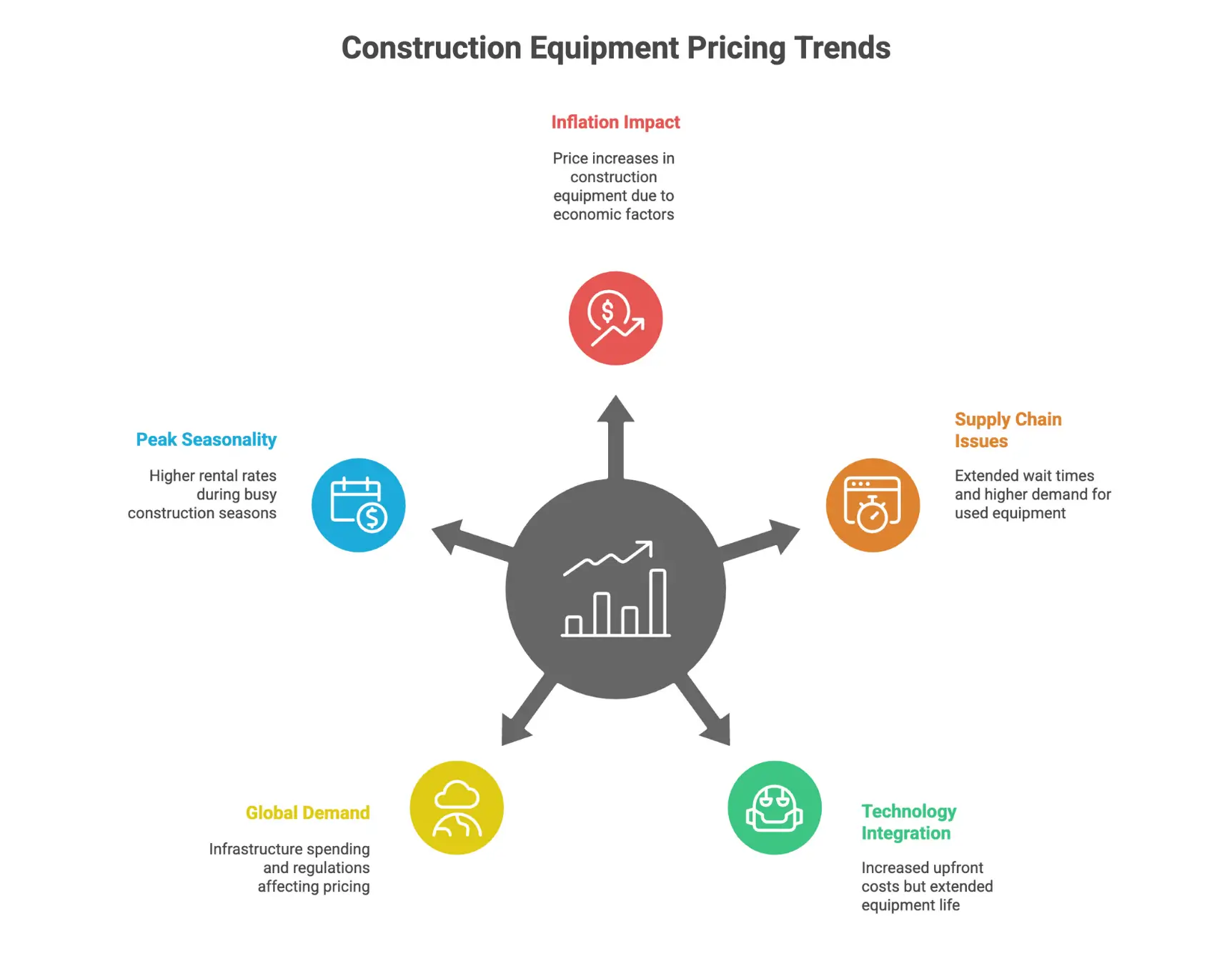
Regularly tracking cost data and understanding the current market is key to making informed purchase decisions.
Managing and Reducing Construction Equipment Costs
Maintenance Strategies
Regular and preventive maintenance is vital because it minimizes downtime and identifies potential issues before they escalate into costly repairs. Always account for maintenance when budgeting, as skipping scheduled care can impact project timelines and increase the overall cost.
Fuel and Operator Management
Monitor fuel usage and fuel efficiency to save money in the long run. Train operators to follow best practices for fuel-efficient use and reduce idle time wherever possible.
Resale Value Considerations
Neglecting resale value underestimates the real picture of equipment ownership costs. Factor in projected resale value when estimating total equipment costs and planning future equipment purchases.
Financial Planning and Decision-Making
Incorporate financing options, such as lease terms and loan terms, when evaluating new machines. Analyzing monthly costs, ownership costs, operating expenses, and available budget ensures cost-effective equipment management and smarter purchasing or leasing equipment decisions.
Technology and Data Analytics in Construction Equipment Management
Construction equipment management has evolved. Using business intelligence and analytics tools streamlines cost data gathering, visualization, and dynamic forecasting.
Equipment Management Software
Employing modern software enables businesses to:
- Integrate real-time data across their fleets
- Visualize complex cost structures using dashboards and reports
- Create accurate cost forecasts based on historical data and current trends
- Prevent costly surprises by spotting performance benchmarks and maintenance timelines
- Make more informed decisions on equipment purchases, repairs, and replacements
AI-driven platforms and centralized cost data make accurate estimating possible and protect against underbidding or hidden costs.
Frequently Asked Questions
What are the key components of construction equipment costs?
A complete estimate should include the initial purchase price, transportation, assembly, installation, regular maintenance, operator wages, fuel costs, insurance, depreciation, storage, repair costs, taxes, and projected resale value.
How do I estimate ongoing operating costs?
Use records of actual fuel usage, maintenance logs, and operator expenses. Factor in the impact of jobsite conditions and age of the equipment. Don’t overlook hidden costs like emergency repairs or unexpected part replacements.
Is renting or purchasing more cost-effective?
Renting construction equipment can be cost-effective for short-term needs or when peak demand inflates purchase prices. For high-use or long-term projects, buying, even used equipment, can offer savings, especially when resale value is considered.
How do market conditions impact equipment costs?
Market supply and demand, inflation, labor and material shortages, and technology upgrades can all influence both purchase and rental prices. Regularly update estimates based on the current market to avoid surprises.
What are the best strategies for allocating equipment costs?
Pool all ownership and operating costs, then assign a share to each project based on percentage of use. This approach ensures every project pays its fair share, and budgeting is more transparent.
Why is maintenance so important for controlling heavy equipment costs?
Regular maintenance extends useful life, reduces downtime, and helps catch problems before they become costly. Poorly maintained equipment often incurs higher repair costs and shortens the equipment’s overall life.
Conclusion: Construction Equipment Costing Is Your Competitive Advantage
Thoroughly estimating and managing construction equipment costs is crucial for project success. Use detailed cost data, revisit benchmarks from past projects, and leverage the latest equipment management software to stay ahead. Regular maintenance, careful financial planning, and a clear understanding of all the key factors will save money, reduce risk, and improve your ability to deliver on budget.
The result is smoother planning, more cost-effective execution, and a stronger competitive edge in the construction industry.
Start Building Accurate Estimates Today
Ready to overhaul your equipment costing? Explore Nomitech’s technology suite or contact their team to discover smart tools for equipment management and accurate cost data. Equip your business with the insights to win more bids and safeguard your bottom line.




